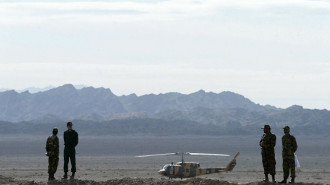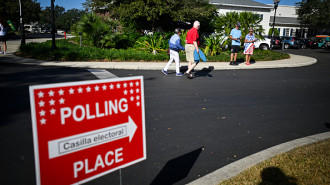Al-Aqsa Mosque still under threat on 55th anniversary of arson attack
The Council of Endowments, Islamic Affairs and Holy Sites in Jerusalem marked on Wednesday the 55th anniversary of the 1969 arson attack on the Al-Aqsa Mosque, warning that the crime's outcome was "still continuing" today, in reference to the numerous raids and attacks carried out by settlers, the army and politicians on the holy site.
The council called the events of 1969 a "heinous crime", with "arsons continuing to this day in forms and dimensions that are no less dangerous in harming the message and identity of the blessed Al-Aqsa Mosque".
It also denounced those "with an extremist mentality calling for destruction, arson, and demolition through successive series of daily incursions by extremist Jewish groups".
What happened in 1969?
Fifty-five years ago, an Australian man living in Israel set fire to the Al-Aqsa Mosque, in an incident described as plunging the Middle East into its "worst crisis" since the Arab-Israeli war in 1967.
Denis Michael Rohan set the mosque’s pulpit ablaze, completely destroying the 12th-century minbar.
The pulpit, then commissioned by Nur ad-Din, the Atabeg of Aleppo, was considered among the Muslim world's finest pieces of architecture.
At 6 a.m. on 21 August, Rohan walked through the Bani Ghanim gate carrying a water bottle and two containers filled with benzene and kerosene. He then entered the mosque around an hour later and placed the containers at the bottom of the pulpit.
He had also placed a kerosene-soaked woollen scarf on one end of the containers, and the other at the footsteps of the pulpit. He then set the scarf alight and escaped.
Smoke emanating from the mosque was visible all over Jerusalem, media reported at the time.
The attack destroyed the Al-Aqsa Mosque's pulpit, as well as southern and southeastern parts of the mosque.
The incident provoked outrage within the Muslim world, leading to protests and riots across the region, with many Palestinian Muslims believing that the incident was part of a "wider Israeli plot" to sow tensions and that Israeli authorities did not react harshly enough with Rohan's sentencing.
Rohan, a Christian, believed he was chosen to carry out the destruction of the mosque upon "divine instruction", in a bid to allow the Jews of Israel to build the 'Third Temple' on the mosque’s location, which would then enable the "second coming" of Jesus.
He thought that the mosque was "interfering with the coming of Christ and the Messiah".
During his trial, Rohan said that "God wanted him to build the new temple, and that he was set to become the king of Jerusalem", Israel news site Ynet said in 2017.
"Yep, I lit the fire in the Al-Aqsa Mosque. I am a descendant of the family of King David, and the queen of England is a relative of mine." He stated that he received a "sign from God" which told him to burn the mosque.
The attack also happened two years after Israel annexed east Jerusalem seeking its control, in a move deemed illegal by the UN Security Council. The move also came as Israel occupied East Jerusalem in 1967.
Rohan, an Australian shearer who had been living in Jerusalem for six months prior, was arrested two days after the attack by Israeli police, before being tried and declared "insane". He was then deported to Australia in 1974 on "humanitarian grounds", so he could seek "psychiatric help" with his family nearby.
He had already attempted to set fire to the mosque 10 days before the incident, on August 11, by pouring kerosene through the keyhole of the southeast gate, though his attempt failed.
Speaking to The New Arab, researcher and writer Nawaf Zaho said Rohan "would not have committed his criminal act if the destructive, right-wing Zionist mentality had not been revealed very early, especially after the aggression and occupation in 1967".
Zaho gave an example of when General Rabbi Shlomo Goren, the then-chief rabbi of the Israeli army told Commander Uzi Narkiss that he was "working to blow up the [Dome of the] Rock and Al-Aqsa Mosque to 'get rid of them once and for all'".
"Between the burning of Al-Aqsa and today, unless everyone rises in favour of saving Jerusalem, Al-Aqsa, and Palestine, [Israel] will never stop swallowing up the city and its Islamic and Christian sanctities".
The Council, and Palestinians in general, believe that such attacks and policies are part of Israel's attempts at the "Judaisation" of Jerusalem, in a bid to erase its Muslim and Christian character to make way for a more Jewish one.
Temple Mount as a justification for attacks
The so-called Third Temple is thought to have been built in ancient times, according to the Book of Zechariah, and is a sentiment echoed by Israeli extremists today, who seek to destroy the Islamic site and make way for the "Temple".
Many extremist Israelis refer to the area Temple Mount, including far-right minister Itamar Ben-Gvir, using it as a "pretext" to raid the mosque and its compound.
Additionally, excavations and archaeologists around the mosque have failed to find evidence over the years that the temple existed, contrary to what some Israelis claim.
Decades later, the Al-Aqsa Mosque remains a point of contention between Palestinians and right-wing Israelis, who have enforced laws reducing Muslim access to the site via increased checkpoints and less valid permits.
The Israeli government has also decreased access to the mosque and compound during the Muslim holy month of Ramadan, with the likes of Ben-Gvir encouraging raids during Jewish holidays.
Raids on the mosque are commonplace, with Israelis often raising Israeli flags and shouting provocative statements in a bid to provoke Palestinian worshippers.
Despite such aggressions, the Al-Aqsa Mosque and its compound have remained emblematic symbols of Palestinian identity and resistance.
![Jerusalem's Al-Aqsa Mosque compound is a national symbol for Palestinians [Getty]](/sites/default/files/styles/large_16_9/public/2025247458.jpeg?h=38d368d7&itok=vOyyUU6V)
![Palestinians mourned the victims of an Israeli strike on Deir al-Balah [Getty]](/sites/default/files/styles/image_684x385/public/2024-11/GettyImages-2182362043.jpg?h=199d8c1f&itok=xSHZFbmc)


![The law could be enforced against teachers without prior notice [Getty]](/sites/default/files/styles/image_684x385/public/2178740715.jpeg?h=a5f2f23a&itok=hnqrCS4x)
 Follow the Middle East's top stories in English at The New Arab on Google News
Follow the Middle East's top stories in English at The New Arab on Google News
![Fakhrizadeh [AFP] Fakhrizadeh [AFP]](/sites/default/files/styles/image_330x185/public/media/images/774C39F7-8F7A-4D67-B998-27D102FCB4A7.png?h=d1cb525d&itok=j9eGvunV)

